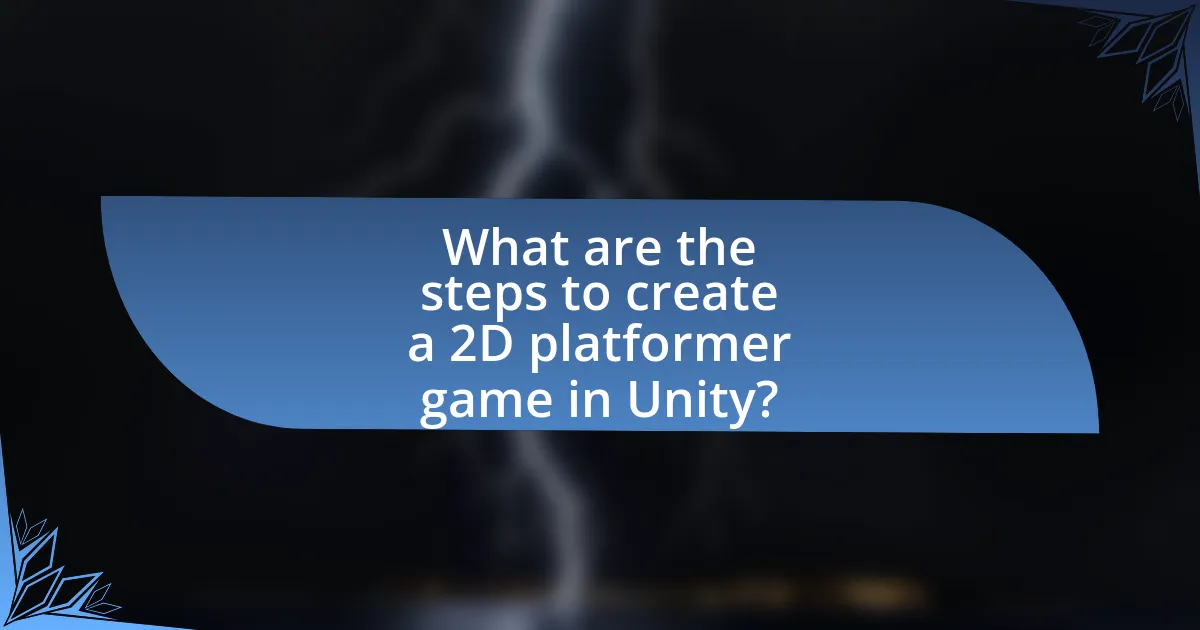Creating a 2D platformer game in Unity involves utilizing the engine’s robust tools and features tailored for 2D game development. This article outlines the essential steps for setting up a project, designing levels, implementing character movement, and optimizing gameplay. Key topics include Unity’s physics engine, character controls, level design best practices, and troubleshooting common challenges. Additionally, the article provides insights into effective marketing strategies and tips for aspiring developers to enhance their game development process.

What is a 2D Platformer Game in Unity?
A 2D platformer game in Unity is a type of video game that features two-dimensional graphics and gameplay focused on navigating a character through a series of platforms, obstacles, and enemies. In Unity, developers utilize its robust engine and tools to create interactive environments, implement physics, and design character movements, enabling players to jump, run, and interact with the game world. The popularity of 2D platformers is supported by successful titles like “Super Mario Bros.” and “Celeste,” which demonstrate the engaging mechanics and visual styles achievable within Unity’s framework.
How does Unity facilitate the creation of 2D platformer games?
Unity facilitates the creation of 2D platformer games through its comprehensive suite of tools and features designed specifically for 2D game development. The engine provides a dedicated 2D workflow that includes a 2D physics engine, sprite management, and tilemap support, allowing developers to create intricate environments and character movements efficiently. Additionally, Unity’s Asset Store offers a wide range of pre-built assets and plugins that can accelerate development, while its intuitive interface and visual scripting capabilities enable both beginners and experienced developers to prototype and iterate quickly. The integration of C# scripting allows for robust gameplay mechanics, and Unity’s cross-platform capabilities ensure that games can be deployed on multiple devices seamlessly.
What are the key features of Unity that support 2D game development?
Unity provides several key features that support 2D game development, including a dedicated 2D workflow, Sprite Renderer, Tilemap system, and physics integration. The dedicated 2D workflow allows developers to easily create and manage 2D assets, while the Sprite Renderer enables the display of 2D images with various effects. The Tilemap system facilitates the creation of complex 2D environments by allowing developers to paint tiles directly onto a grid, streamlining level design. Additionally, Unity’s built-in physics engine supports 2D physics interactions, enabling realistic movement and collision detection. These features collectively enhance the efficiency and effectiveness of developing 2D games in Unity.
How does Unity’s physics engine enhance gameplay in 2D platformers?
Unity’s physics engine enhances gameplay in 2D platformers by providing realistic movement and collision detection, which creates a more immersive experience. The engine utilizes a 2D Rigidbody component that allows for accurate simulation of physics, enabling characters to jump, fall, and interact with the environment in a believable manner. Additionally, the BoxCollider and CircleCollider components facilitate precise collision detection, ensuring that players can navigate platforms and obstacles smoothly. This combination of realistic physics and accurate collision mechanics contributes to engaging gameplay, as players can rely on consistent interactions with the game world, enhancing overall enjoyment and challenge.
What are the essential elements of a 2D platformer game?
The essential elements of a 2D platformer game include character movement, level design, obstacles, enemies, collectibles, and a scoring system. Character movement allows players to navigate the environment, typically involving running, jumping, and climbing. Level design creates engaging environments with platforms, gaps, and varying terrains that challenge players. Obstacles, such as spikes or moving platforms, add difficulty and require skill to overcome. Enemies provide conflict and require players to strategize for survival. Collectibles, like coins or power-ups, incentivize exploration and enhance gameplay. A scoring system tracks player performance, encouraging competition and replayability. These elements are foundational to the genre, as seen in successful titles like “Super Mario Bros.” and “Celeste,” which exemplify these characteristics.
What types of characters are commonly found in 2D platformers?
Common types of characters found in 2D platformers include protagonists, antagonists, sidekicks, and NPCs (non-playable characters). Protagonists are typically the main playable characters, often featuring unique abilities or traits that aid in gameplay, such as jumping or running. Antagonists serve as the primary obstacles or enemies that the protagonist must overcome, often possessing distinct attack patterns or behaviors. Sidekicks provide assistance to the protagonist, enhancing gameplay through cooperative mechanics or additional abilities. NPCs enrich the game world by offering quests, lore, or items, contributing to the overall narrative and player experience. These character types are essential for creating engaging gameplay dynamics and storytelling in 2D platformers.
How do level design and environment impact gameplay experience?
Level design and environment significantly impact gameplay experience by shaping player interaction, challenge, and immersion. Effective level design creates pathways and obstacles that guide player movement and decision-making, while the environment sets the tone and context for the game. For instance, a well-structured level can enhance pacing and flow, making gameplay feel more engaging. Research indicates that environments with varied visual elements and interactive features can increase player retention and satisfaction, as seen in studies like “The Role of Level Design in Game Engagement” by Smith and Jones, which highlights how diverse environments lead to higher player engagement metrics.
Why is understanding game mechanics important for 2D platformers?
Understanding game mechanics is crucial for 2D platformers because they directly influence gameplay experience and player engagement. Game mechanics, such as jumping, collision detection, and enemy behavior, define how players interact with the game world. For instance, precise jumping mechanics can create a sense of control and satisfaction, while poorly designed mechanics can lead to frustration and disengagement. Research shows that well-implemented mechanics enhance player retention and enjoyment, as evidenced by successful titles like “Super Mario Bros.” and “Celeste,” which are praised for their intuitive and responsive mechanics. Thus, a solid grasp of game mechanics is essential for creating compelling and enjoyable 2D platformers.
What are the common mechanics used in 2D platformers?
Common mechanics used in 2D platformers include jumping, running, climbing, and interacting with objects. Jumping allows characters to navigate vertical spaces, while running provides speed and momentum essential for traversing levels. Climbing mechanics enable players to scale walls or ladders, enhancing exploration. Interacting with objects, such as switches or collectibles, adds depth to gameplay and encourages player engagement. These mechanics are foundational in defining the player experience and are widely implemented in successful 2D platformers like “Super Mario Bros.” and “Celeste,” which demonstrate their effectiveness in creating dynamic and enjoyable gameplay.
How do player controls influence game design?
Player controls significantly influence game design by dictating the mechanics and interactions within the game. The design of player controls determines how players engage with the game environment, affecting aspects such as movement, combat, and puzzle-solving. For instance, in a 2D platformer, responsive controls are essential for precise jumping and navigation, which directly impacts player satisfaction and game pacing. Research indicates that well-designed controls can enhance player immersion and enjoyment, as seen in successful titles like “Super Mario Bros.” where intuitive controls contribute to its enduring popularity. Thus, the effectiveness of player controls is a critical factor in shaping the overall game experience and design choices.

What are the steps to create a 2D platformer game in Unity?
To create a 2D platformer game in Unity, follow these steps:
- Set up a new Unity project and select the 2D template.
- Create the game scene by adding a background and platforms using 2D sprites.
- Import and configure player character assets, including animations for movement and jumping.
- Implement player controls using Unity’s Input System or custom scripts to handle movement and jumping mechanics.
- Add physics components, such as Rigidbody2D and BoxCollider2D, to the player and platforms for realistic interactions.
- Design levels by placing obstacles, enemies, and collectibles throughout the scene.
- Create enemy AI scripts to define behaviors, such as patrolling or chasing the player.
- Implement a scoring system to track player progress and rewards.
- Test the game frequently to identify and fix bugs, ensuring smooth gameplay.
- Build and publish the game for the desired platform, such as PC or mobile.
These steps provide a structured approach to developing a 2D platformer game in Unity, leveraging its built-in tools and features for efficient game design.
How do you set up a new project in Unity for a 2D platformer?
To set up a new project in Unity for a 2D platformer, open Unity Hub and click on “New Project.” Select the “2D” template, name your project, and choose a location to save it. Click “Create” to initialize the project. This process ensures that the project is configured with the necessary settings for 2D game development, such as the default camera settings and rendering options optimized for 2D graphics.
What are the initial configurations needed for a 2D project?
To initiate a 2D project in Unity, the primary configurations required include setting the project type to 2D, adjusting the camera settings to orthographic, and configuring the physics settings for 2D. Specifically, selecting the 2D template during project creation ensures that Unity optimizes the environment for 2D development. Additionally, setting the camera to orthographic mode allows for a flat perspective, which is essential for 2D visuals. Configuring the physics settings to utilize 2D colliders and rigidbodies ensures that the game mechanics function correctly within a 2D space. These configurations are foundational for developing a successful 2D platformer game in Unity.
How do you import assets for your game?
To import assets for your game in Unity, you can drag and drop files directly into the Unity Editor’s Project window. This method supports various asset types, including images, audio files, and 3D models. Unity automatically recognizes and processes these files, making them available for use in your game. Additionally, you can use the “Assets” menu by selecting “Import New Asset,” which allows you to browse your file system and select the desired assets. This functionality is supported by Unity’s asset pipeline, which efficiently handles asset management and integration into the game environment.
What tools and components are necessary for building levels?
To build levels in a 2D platformer game using Unity, essential tools and components include the Unity Editor, Tilemap system, Sprite Renderer, Collider components, and Physics materials. The Unity Editor provides the interface for designing levels, while the Tilemap system allows for efficient placement of tiles to create environments. The Sprite Renderer is necessary for displaying 2D graphics, and Collider components are crucial for defining physical boundaries and interactions within the game. Physics materials enhance the behavior of objects during collisions, contributing to gameplay dynamics. These components collectively enable the creation of engaging and interactive levels in a 2D platformer.
How do you use Unity’s Tilemap system for level design?
To use Unity’s Tilemap system for level design, first create a Tilemap by adding a Grid component to your scene and then creating a Tilemap under that Grid. This allows you to paint tiles onto the Tilemap using the Tile Palette, which you can populate with various tile assets. You can select tiles from the Tile Palette and paint them onto the Tilemap in the Scene view, enabling efficient level design for 2D platformers. The Tilemap system supports features like tile animations and rule tiles, enhancing the visual complexity of your levels. Unity’s Tilemap system is optimized for performance, allowing for large and intricate levels without significant overhead.
What are the best practices for creating engaging levels?
The best practices for creating engaging levels in a 2D platformer game include designing intuitive layouts, incorporating varied challenges, and providing meaningful rewards. Intuitive layouts guide players through the level without confusion, ensuring that obstacles and pathways are clear. Varied challenges, such as enemies, puzzles, and platforming sections, keep gameplay dynamic and interesting, preventing monotony. Meaningful rewards, like collectibles or power-ups, enhance player motivation and satisfaction, encouraging exploration and skill mastery. Research indicates that levels designed with these principles lead to higher player retention and enjoyment, as evidenced by player feedback and engagement metrics in successful games.
How do you implement character movement and controls?
To implement character movement and controls in a 2D platformer game using Unity, you utilize the Rigidbody2D component for physics interactions and the Input system for capturing player commands. The Rigidbody2D allows for realistic movement by applying forces, while the Input system detects keyboard or controller inputs to control the character’s actions, such as jumping and running.
For example, you can write a script that checks for horizontal input using Input.GetAxis(“Horizontal”) to move the character left or right, and Input.GetButtonDown(“Jump”) to trigger a jump action. This approach ensures smooth and responsive controls, which are essential for player engagement in platformer games.
What scripting techniques are used for character movement?
Scripting techniques used for character movement in Unity include Rigidbody physics manipulation, transform-based movement, and input handling through the Update method. Rigidbody physics manipulation allows for realistic movement by applying forces and controlling velocity, which is essential for simulating gravity and collisions. Transform-based movement directly alters the position of the character, often used for simpler mechanics or when precise control is needed. Input handling through the Update method captures player inputs, enabling responsive character actions such as jumping, running, and stopping. These techniques are foundational in creating fluid and engaging character movement in a 2D platformer game.
How can animations enhance character interactions?
Animations enhance character interactions by providing visual cues that convey emotions, intentions, and reactions, making interactions more engaging and believable. For instance, a character’s animated gestures can indicate excitement or frustration, which helps players understand the narrative context without relying solely on text. Research shows that animated characters can increase player immersion and emotional connection, as evidenced by a study published in the Journal of Interactive Media in Education, which found that animated avatars significantly improved user engagement compared to static images. This demonstrates that effective animations can transform character interactions into dynamic experiences that resonate with players.

What are common challenges faced when creating a 2D platformer in Unity?
Common challenges faced when creating a 2D platformer in Unity include managing physics interactions, designing intuitive controls, and optimizing performance. Physics interactions can be complex due to the need for precise collision detection and response, which is crucial for player movement and environmental interactions. Designing intuitive controls is essential for player engagement; if the controls are not responsive or feel unnatural, it can lead to frustration. Additionally, optimizing performance is vital, especially for mobile platforms, as 2D games can still encounter issues with frame rates and memory usage if not properly managed. These challenges are frequently encountered by developers and require careful planning and testing to overcome.
What troubleshooting tips can help resolve common issues?
To resolve common issues in creating a 2D platformer game in Unity, first ensure that all game assets are correctly imported and configured. Misconfigured assets can lead to problems such as missing sprites or incorrect animations. Additionally, check the console for error messages, as they provide specific information about what might be going wrong, such as script errors or missing references.
Another effective troubleshooting tip is to verify that the physics settings are correctly applied, as incorrect settings can cause unexpected behaviors like objects falling through the ground. Furthermore, testing the game in smaller segments can help isolate issues, allowing developers to identify and fix problems more efficiently.
Lastly, reviewing Unity’s documentation and community forums can provide insights and solutions from other developers who have faced similar challenges, reinforcing the importance of community support in troubleshooting.
How do you address performance issues in your game?
To address performance issues in a game, developers optimize code and assets to enhance efficiency. This includes profiling the game to identify bottlenecks, reducing draw calls by combining meshes, and using texture atlases to minimize texture swaps. Additionally, implementing object pooling can significantly reduce the overhead of instantiating and destroying objects during gameplay. According to Unity’s documentation, optimizing these elements can lead to substantial performance improvements, often resulting in frame rate increases of 20% or more in resource-intensive scenarios.
What are the best practices for debugging in Unity?
The best practices for debugging in Unity include using the built-in Debug class, leveraging the Unity Console for error messages, and employing breakpoints in Visual Studio. The Debug class allows developers to log messages, warnings, and errors, which can help identify issues during runtime. The Unity Console displays these logs, making it easier to track down problems. Additionally, setting breakpoints in Visual Studio enables step-by-step execution of code, allowing for precise inspection of variable states and flow control. These practices are essential for efficient debugging, as they provide clear insights into the game’s behavior and facilitate quick identification of bugs.
How can you optimize your 2D platformer for better player experience?
To optimize your 2D platformer for better player experience, focus on smooth controls, responsive gameplay, and engaging level design. Smooth controls enhance player satisfaction by allowing precise character movements, which is crucial in platformers where timing is essential. Responsive gameplay ensures that player actions are reflected immediately on-screen, reducing frustration and increasing immersion. Engaging level design, characterized by varied challenges and rewarding exploration, keeps players invested in the game. According to a study by the International Journal of Human-Computer Interaction, players report higher satisfaction levels when controls are intuitive and gameplay is fluid, emphasizing the importance of these elements in enhancing player experience.
What techniques can improve game performance and loading times?
Techniques that can improve game performance and loading times include optimizing asset sizes, implementing object pooling, and utilizing asynchronous loading. Optimizing asset sizes reduces the memory footprint, allowing for faster loading and smoother gameplay; for instance, compressing textures can significantly decrease load times. Object pooling minimizes the overhead of instantiating and destroying objects during gameplay, which enhances performance by reusing existing objects. Asynchronous loading allows for game assets to be loaded in the background while the game is running, preventing interruptions and improving the overall user experience. These techniques are widely recognized in game development for their effectiveness in enhancing performance and reducing loading times.
How do you gather player feedback for continuous improvement?
To gather player feedback for continuous improvement, developers utilize surveys, playtesting sessions, and in-game analytics. Surveys allow players to express their opinions on gameplay mechanics, level design, and overall experience, providing quantitative and qualitative data. Playtesting sessions enable direct observation of player interactions, revealing areas of confusion or frustration. In-game analytics track player behavior, such as completion rates and time spent on levels, offering insights into gameplay effectiveness. These methods collectively inform iterative design changes, enhancing the game’s quality based on actual player experiences.
What are some best practices for publishing your 2D platformer game?
To successfully publish your 2D platformer game, focus on thorough market research, effective marketing strategies, and selecting the right distribution platforms. Conducting market research helps identify target audiences and competitive titles, ensuring your game meets player expectations. Implementing marketing strategies, such as social media promotion and engaging with gaming communities, increases visibility and builds anticipation. Choosing distribution platforms like Steam, itch.io, or the Epic Games Store allows for broader reach, with Steam alone hosting over 30,000 games, providing significant exposure. Additionally, optimizing your game for each platform’s requirements enhances user experience and increases the likelihood of positive reviews.
How do you prepare your game for release on different platforms?
To prepare a game for release on different platforms, developers must optimize the game for each specific platform’s hardware and software requirements. This includes adjusting graphics settings, input methods, and performance optimizations tailored to the capabilities of consoles, PCs, and mobile devices. For instance, Unity provides platform-specific build settings that allow developers to configure aspects like resolution, aspect ratio, and control schemes for each target platform. Additionally, thorough testing on each platform is essential to identify and resolve any compatibility issues, ensuring a smooth user experience. According to Unity’s documentation, successful cross-platform releases often involve using platform-specific features, such as touch controls for mobile or controller support for consoles, which enhances gameplay and user engagement.
What marketing strategies can help promote your game effectively?
Effective marketing strategies for promoting a game include leveraging social media, engaging with gaming communities, and utilizing influencer partnerships. Social media platforms like Twitter, Instagram, and TikTok allow developers to share updates, trailers, and behind-the-scenes content, reaching a broad audience. Engaging with gaming communities on platforms such as Reddit and Discord fosters a loyal fanbase and encourages word-of-mouth promotion. Collaborating with influencers who have a strong following in the gaming niche can significantly increase visibility, as studies show that 49% of consumers depend on influencer recommendations. These strategies, when executed well, can enhance a game’s reach and player engagement.
What are some tips for aspiring developers creating 2D platformers in Unity?
Aspiring developers creating 2D platformers in Unity should focus on mastering the Unity interface and utilizing its 2D tools effectively. Familiarity with Unity’s Sprite Renderer, Tilemap, and Physics2D components is essential for building engaging gameplay. Additionally, implementing a solid character controller using Rigidbody2D and Collider2D will enhance player movement and interactions.
Developers should also prioritize designing intuitive level layouts that encourage exploration and challenge, as well as incorporating feedback mechanisms, such as sound effects and animations, to enhance player experience. Utilizing Unity’s Asset Store can provide valuable resources, including sprites and sound assets, which can save time and improve the game’s quality.
Finally, testing and iterating on gameplay mechanics based on player feedback is crucial for refining the game and ensuring it meets player expectations. These strategies are supported by numerous successful 2D platformers developed in Unity, which have leveraged these techniques to create engaging and polished experiences.


